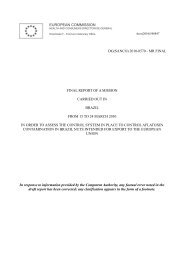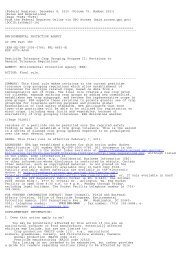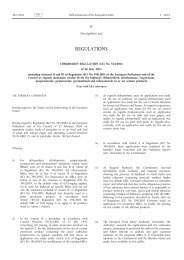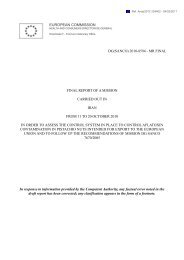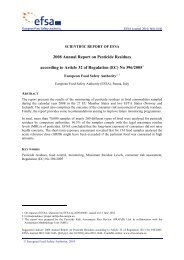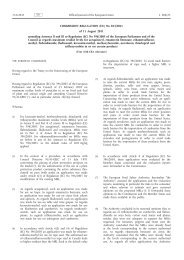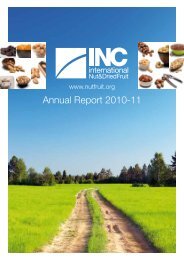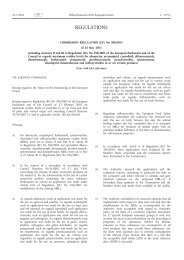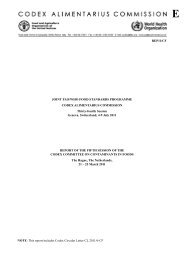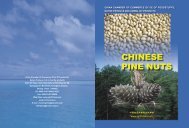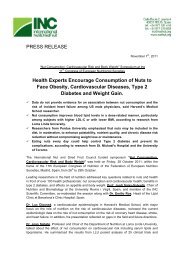REP11/PR JOINT FAO/WHO FOOD STANDARDS PROGRAMME ...
REP11/PR JOINT FAO/WHO FOOD STANDARDS PROGRAMME ...
REP11/PR JOINT FAO/WHO FOOD STANDARDS PROGRAMME ...
You also want an ePaper? Increase the reach of your titles
YUMPU automatically turns print PDFs into web optimized ePapers that Google loves.
<strong>REP11</strong>/<strong>PR</strong> 12<br />
STATUS OF THE DRAFT <strong>PR</strong>INCIPLES AND GUIDANCE ON THE SELECTION OF RE<strong>PR</strong>ESENTATIVE COMMODITIES FOR THE EXTRAPOLATION OF<br />
MRLS TO COMMODITY GROUPS<br />
111. The Committee agreed to hold the Draft Principles and Guidance (including Table 1 on fruit commodities) at Step 7 pending<br />
the finalization of the revision of the Classification of Foods and Animal Feeds as per the fruit types (Appendix IX).<br />
DISCUSSION PAPER ON THE GUIDANCE TO FACILITATE THE ESTABLISHMENT OF MAXIMUM RESIDUE LIMITS FOR<br />
PESTICIDES FOR MINOR USE AND SPECIALTY CROPS (Agenda Item 9) 15<br />
112. The Delegation of the United States of America, as Chair of the electronic Working Group on Minor Use and Specialty Crops,<br />
introduced the document highlighting the major issues associated with the establishment of maximum residue limits for pesticides for<br />
minor use and specialty crops as presented in CX/<strong>PR</strong> 11/43/9. As regards the definition of minor use and specialty crops, the<br />
Delegation recalled that the last session of the Committee did not endorse the recommendation for guidance from JM<strong>PR</strong> on the<br />
number of residue field trials necessary to perform the evaluation as there was not an agreed international definition nor any agreed<br />
data requirements for minor use. The Delegation noted that there is currently no agreement on a definition due to difficulties in<br />
reaching consensus as per what could be considered a minor use and specialty crop vis-à-vis the production and consumption of the<br />
same commodity in different countries and regions. In view of this, criteria as opposed to definition, for use by CC<strong>PR</strong> and JM<strong>PR</strong> to<br />
determine the minimum number of field trials necessary to support the establishment of MRLs for minor use and specialty crops<br />
could be more appropriate to assist member countries in the identification of minor use/specialty crops and the submission of data to<br />
JM<strong>PR</strong>.<br />
113. Several delegations supported the development of criteria for use by CC<strong>PR</strong>/JM<strong>PR</strong> and generally favoured the dietary intake<br />
contribution and total production/cultivation area as relevant criteria to address risk assessment for the establishment of MRLs for<br />
minor use and specialty crops. Therefore, economic factors should not be taken into account when further developing the criteria.<br />
Some of these delegations noted that the development of criteria could later on assist in the elaboration of a definition for minor use<br />
and specialty crops that could then be agreed upon by Codex members.<br />
114. In regard to the two criteria identified, several delegation were of the opinion that, in order to provide for more flexibility in their<br />
application worldwide, the cut off figures for dietary intake contribution and the total production area should rather be expressed in<br />
percentages of the global total daily diet (based on GEMS Food Data) and of the world food production (based on <strong>FAO</strong>STAT)<br />
however a higher tonnage production than currently presented in the discussion paper should be considered.<br />
115. The Delegation of the EU noted that clarity was needed on the terminology used in the discussion paper to address these<br />
commodities i.e. minor use, minor crops and specialty crops. The Delegation indicated that the terms minor/major crops are used to<br />
define a food safety issue and the number of trials necessary for MRLs setting hence the daily intake contribution and cultivation<br />
area are relevant criteria to identify minor crops. In this regard, the Delegation noted that the discussion paper did not clearly<br />
differentiate between minor crop and minor use and that the latter was more related to the economic return on the use of a pesticide<br />
in relation to the registration costs which in no case would reduce the number of trials required for the establishment of MRLs for the<br />
minor crop. It was noted that, in this framework, there could be major crops with minor use and vice-versa. The delegation also noted<br />
that the discussion paper neither clearly differentiate between “minor crop” and “specialty crop” and that both terms should clearly be<br />
understood for the purposes of MRLs setting by CC<strong>PR</strong>.<br />
Conclusion<br />
116. Based on the above considerations, the Committee agreed to re-establish the electronic working group chaired by the United<br />
States of America and co-chaired by Kenya and Thailand to work on the development of criteria for use by CC<strong>PR</strong> and JM<strong>PR</strong> to<br />
determine the minimum number of field trials necessary to support the establishment of MRLs for minor crops/specialty crops in<br />
order to facilitate data submission to JM<strong>PR</strong>. The Committee agreed that the electronic working group will hold a meeting prior to the<br />
44 th Session of the CC<strong>PR</strong> and that both the electronic and physical working groups will work in English only.<br />
<strong>PR</strong>OPOSED DRAFT REVISION OF THE GUIDELINES ON THE ESTIMATION OF UNCERTAINTY OF RESULTS FOR THE<br />
DETERMINATION OF PESTICIDE RESIDUES (Agenda Item 10a) 16<br />
117. The Committee recalled that its last session had agreed to return the proposed draft Guidelines to Step 3 for consideration at<br />
this session.<br />
15 CX/<strong>PR</strong> 11/43/9. Comments from Kenya (CRD 5); CropLife (CRD 6); Thailand (CRD 8); Colombia (CRD 9); Argentina (CRD 10); China (CRD 19); Nigeria<br />
(CRD 20); Mali (CRD 21); EU (CRD 22); and OECD (CRD 29).<br />
16 CX/<strong>PR</strong> 11/43/10; CX/<strong>PR</strong> 11/43/10-Add.1 (Comments from Canada and Cuba). Additional comments from Kenya (CRD 5); Colombia (CRD 9); Japan (CRD<br />
13); EU (CRD 15); China (CRD 19); Mali (CRD 21); and Japan (CRD 23). Report of the in-session Working Group on Methods of Analysis (CRD 30).



